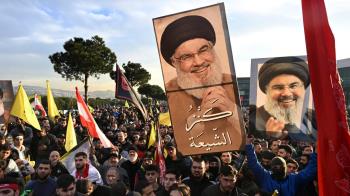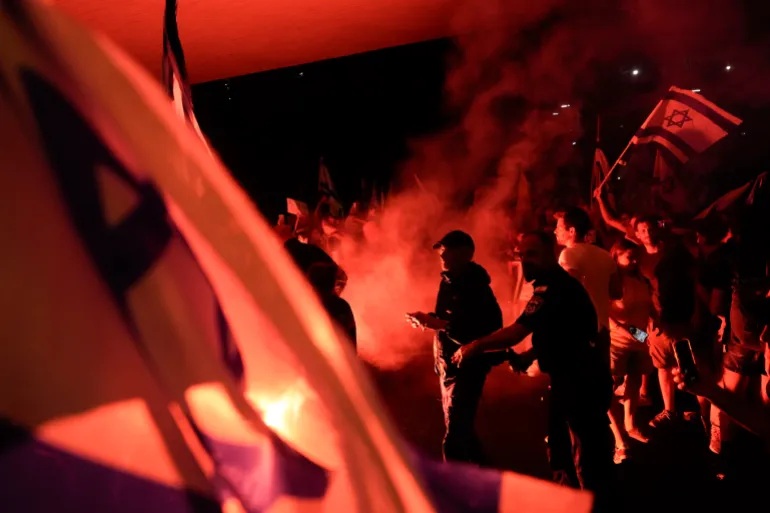Alwaght- 10 months after start of the genocidal war on Gaza and killing and injuring of tens of thousands of Palestinians, the Israelis not only have not managed to obliterate Hamas resistance movement, but also even razing Gaza to the ground has not helped locate the Israeli prisoners, to an extent that Netanyahu critics argue that further search will only kill more prisoners.
In the latest development, on Monday, the Israeli army announced that it found the bodies of 6 prisoners without prior information and only during the search of the Rafah tunnels near the place where Farhan Al-Qazi, another prisoner, was found.
The announcement of this news and then the leaking of information that some of those killed were on the swap list caused public anger against the Netanyahu government in the occupied territories, which in turn increased the tensions in the Israeli cabinet, a situation that has put Netanyahu in another predicament and he has once again pushed him to fabricate another narrative.
General strike
The announcement of the discovery of the six dead prisoners infuriated the Israelis and a wave of nationwide protests in the occupied territories that are seen biggest since beginning of war in October 2023.
Public outrage was fueled by the announcement that the killed prisoners were to be part of a prisoner exchange if a ceasefire agreement was reached. Protesters argue that Netanyahu has shown that he does not value the lives of prisoners for his personal interests and for his power.
Yoaz Hendel, former Israeli communications minister, said that "finding body of each abductee in Gaza means a defeat for Netanyahu cabinet. We have no word assuring the families of the abductees."
"We paid a heavy price this week. Many of our soldiers were killed and the abductees are returning to Israel in coffins," he was quoted as saying.
A Hamas leader, who spoke on the condition of anonymity, told the AFP that some of the hostages whose bodies were found in Rafah were on a list that Hamas had agreed to release if a ceasefire was agreed upon.
Also, two Israeli officials told CNN that three of the six hostages were supposed to be released in the first phase of the final ceasefire agreement.
On Sunday evening, some 300,000 people took to the streets, blocking roads and calling on the government to accept a ceasefire and pave the way for the rescue of the estimated 100 remaining prisoners in Gaza.
On Monday, the Histadrut, the largest trade union in the occupied territories - representing some 800,000 workers - called a one-day general strike in support of the protesters. The call was supported by the Israel's High-tech Association, which resulted in the shutdown of large parts of the regime's economy for several hours.
The Israel Chamber of Commerce, which represents the majority of private sector workers from 200 of the country's largest companies, also joined the strike.
Also, Ben-Gurion International Airport, which is considered the main international gateway of the Israeli regime, was closed at 8:00 a.m. Israeli time.
Many government and municipal offices were also closed on Monday. Tel Aviv Municipality, which provides services to the economic center of this regime, was one of these departments.
In addition to this general strike, according to the statement of the Association of Families of Hostages and Missing Persons, the demonstrators plan to block important roads and intersections along with the entrances of many government and regional offices in the coming days.
Thia strike led to the intervention of the labor court to return the workers to the factories. Accusing Histadrut head Arnon Bar-David of trying to "undermine Israel's economy in favor of Hamas," hardline Finance Minister Bezalel Smotrich submitted an urgent request to the attorney general to order an end to the strike.
Gallant-Netanyahu clash
While the escalation of tensions between the members of the regime's cabinet, especially the gap between Netanyahu and Minister of Defense Yoav Gallant, has been fully revealed in recent months, the Israeli media outlets have reported a renewed verbal conflict between them after the dead prisoners were found.
Galant said in the security and political cabinet meeting that there is not enough time left to release the Israeli prisoners who are still alive in Gaza.
On Sunday, after the bodies of the prisoners were found, Gallant apologized to their families and asked the cabinet to reconsider its decision to block the ceasefire agreement.
Some ministers of Netanyahu's cabinet are very angry with Gallant's request to cancel the decision of the security and political cabinet regarding the retention of this regime's forces in the Philadelphi Corridor between Gaza and Egypt.
At the same time, Netanyahu claims to have accepted what was agreed upon with the Americans, and it is impossible to show flexibility about a fundamental issue like the Philadelphi Corridor.
Those close to the PM emphasized that defense minister is looking to spark protests against Netanyahu's cabinet, and the PM's office attacked him vehemently, saying "Gallant has lost his mind."
Israel's repetitive narrative of the death of prisoners
As Netanyahu is facing a heavy wave of public protest, he turns to the threadbare game of fabricating narratives to get rid of pressures.
In the first public reaction to the news of the killing of hostages in the search operation in Rafah city, Netanyahu expressed his regret for the death of these six prisoners and accused Hamas of killing these hostages "in cold blood" and gold the movement responsible.
The Ministry of Health of the regime also announced, in line with the PM's narrative, that the autopsy results of the bodies of the six Israeli hostages who were transferred from Gaza to Israel on Sunday morning, show that they were shot from "very close range" between Thursday and Friday morning. Shira Solomon, the spokesperson of the regime's health ministry, announced in a statement: "These six hostages were shot dead by Hamas from a very close range."
It seems that with this narrative, Netanyahu seeks to show that the decision to continue the search operation for prisoners in Gaza instead of the ceasefire agreement is a correct decision and the chances of finding the rest of the prisoners are high.
Still, a look at similar events in the past months shows that the regime has created false narratives in such circumstances. For example, after the bodies of three prisoners were found in Gaza on May 28, Daniel Hagari, the spokesman of the army, announced that they were killed in a Hamas attack on October 7 while escaping from the Nova music festival, and their bodies was transferred to Gaza. According to this statement, the army and Shabak forces in a "successful operation" were able to return these bodies without conflict with Hamas forces.
But at the time, Izzat al-Risheq, a Hamas commander, in a Telegram post cast doubt on the way the bodies were returned, adding that "we do not trust the Israeli narrative and emphasize that statements of resistance are the certain word in this issue."
He added that these bodies may belong to people who were killed earlier during the Israeli bombardment and remained under the rubble until Thursday when the Israeli army found them.
In fact, the Israeli army, and Netanyahu, who have completely destroyed 70 percent of Gaza with the massive bombing of Gaza over the past 10 months, are creating fake narratives to skip responsibility of killing these prisoners during their carpet bombing campaign.
Latest estimates of dead and living prisoners
Currently, there are no precise data on the number of Israeli prisoners held by resistance forces.
Citing Israeli officials, Israeli media say that about 250 Israelis were captured since October 7, from whom 101, including 35 believed to have died, remain in captivity.
Meanwhile, most of the prisoners who returned home alive were those who were freed during a one-week ceasefire of November in return for release of Palestinian prisoners. 8 were also found alive during a search operation, and Hamas announced that it had released some of these prisoners for humanitarian reasons and because of their illness and condition deterioration and the lack of medical facilities for treatment.



























